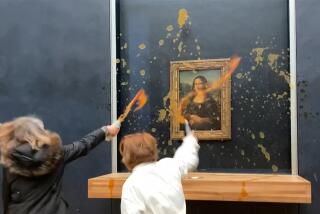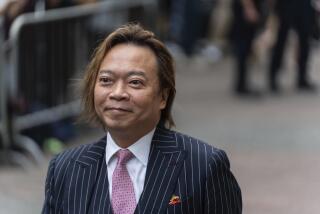In Hong Kong, a tale of two sit-ins -- gritty and intellectual
- Share via
Reporting from Hong Kong — As Hong Kong’s pro-democracy protests continued overnight into Monday, demonstrators in this city’s financial district of Admiralty showed solidarity through oil paintings and sculpture while engaging in salon-style debates against the backdrop of glamorous five-star hotels and steel and glass office towers.
Across Hong Kong Harbor in the gritty neighborhood of Mong Kok, protesters were trading barbs with hoodlums, fending off drunks and drawing stares from bewildered mainland Chinese tourists winding through the area’s maze of street stalls and seedy massage parlors.
The protesters at both sites had congregated for the same reason: to demand fully democratic elections to choose Hong Kong’s top leader. But the two sites they chose to occupy are a study in contrasts in this restive city of 7 million, a tale of two sit-ins.
Strolling through the protest area in Admiralty – which is on Hong Kong Island’s harbor front, a name that reflects the territory’s history as a British naval outpost – feels like taking in a late-night community art fair filled with intellectuals, hipsters and creative bohemians.
The sit-in centered in Mong Kok, a hyper-dense residential and commercial district in the heart of the city’s Kowloon Peninsula, evokes an outdoor nightclub choked with cigarette smoke, flamboyantly dressed youth and gangs of amply tattooed men who look like they stepped out of a Hong Kong triad gangster film. Its name in Chinese means “busy corner.”
“Mong Kok is cowboy territory; you get all walks of life,” said Willy Lam, a political analyst and professor at the Chinese University of Hong Kong. “Admiralty is more buttoned down. You wouldn’t get the triads there unless they were coming out of the high court.”
Admiralty was chosen by protest organizers because it houses the city government’s headquarters. Mong Kok’s sit-in developed spontaneously on Sept. 28 after riot police fired tear gas into the crowds in Admiralty.
Mong Kok is home to some of Hong Kong’s poorest citizens, exemplifying why the city has one of the largest income disparities in the world.
Its vibrant shopping scene is also the source of a phenomenon called “Mong Kok Style,” an anything goes aesthetic that emphasizes wild hair, bargain bin clothes and makeup for women and men.
Counterculture thrives in the congested streets and sidewalks of Mong Kok, which is also synonymous with organized criminal gangs and prostitution. It’s a theme often explored in films such as the 2004 hit “One Night in Mong Kok.”
Police say triads were found to be among the men who attacked pro-democracy demonstrators there Friday. In the days that followed, hoodlums, residents and shopkeepers heckled the protesters and complained about the disruption they were causing.
“What if I came to your neighborhood and blocked you?” shouted a counter-demonstrator on Saturday.
While protesters were contemplating the intersection of civil disobedience and art in Admiralty, their counterparts in Mong Kok were locked in shouting matches with opponents peppered with profanity and the occasional shove. Dozens of people were later arrested for fighting.
“It’s not safe there,” said Joanna Lai, a 22-year-old hotel worker explaining why she chose to demonstrate in Admiralty instead.
Anthony Chui, a 27-year-old accountant and pro-democracy demonstrator, left Admiralty for Mong Kok on Saturday after he heard protesters there were besieged by thugs.
He said the neighborhood’s transformation in recent years from mostly mom-and-pop storefronts to jewelry shops pandering to mainland tourists was emblematic of Hong Kong’s cultural demise.
“Mong Kok is supposed to be a signature part of Hong Kong,” Chiu said Sunday. “It’s where people worked hard and started small businesses. Now it’s just shops for mainlanders. They come here to shop and buy real estate all over the city, making housing unaffordable for Hong Kong people. It’s totally unacceptable.”
Later that night, as hundreds of police amassed in the area, life went on as usual in the back streets. Outdoor vendors sold lingerie and knock-off name brand clothes. A street performer belted a karaoke version of Rod Stewart’s “I Am Sailing.” A food stall saw steady business for its curry fish balls and pig intestine on a stick.
Demonstrators around the block set up turntables and a public address system to blast electronic dance music.
Around the same time, more refined activities were taking hold at the Admiralty sit-in.
Noah Wong passed time by reading “The Ugly Chinaman and the Crisis of Chinese Culture,” a book by the late Bo Yang, a Taiwanese social commentator and human rights campaigner. Nearby, an artist who goes by the name Perry Dino had set up his easel and was capturing the protest scene in oil color. Two years ago, he quit his job as a secondary school art teacher.
“This may be the last night, the last painting in my series,” said Dino, who has made eight different oil colors chronicling the protest movement, starting from August.
Moments before, some art-school graduates had burst upon the scene, rolling in a large wooden sculpture of a man holding an umbrella — the symbol of the protest movement for its use blocking police pepper spray. Within minutes, Dino had daubed the brown, white and yellow figure into his street scene.
Over toward the curb, Chris Cheung and two other artist friends had set up a pricey-looking video projector and were displaying messages of support for the demonstrations that they had solicited through a Facebook page.
“Stay strong!” read one note from Taiwan flashed up on the side of a government building. Elsewhere in the encampment, a young man played a guitar. On the fence in front of government headquarters, someone had posted the lyrics and chord progression for “The Umbrella Song,” a protest anthem set to the tune of “La Marseillaise.”
In front of the chief executive’s office, a police officer engaged protesters in an impromptu discussion session about protest methods and how the week’s events might deepen social divisions in Hong Kong society.
The encampment was well-stocked with food and medical supplies. Volunteers walked through the crowds offering packaged cookies and homemade baked goods. Helpers flanked barriers that divide the main highway running through the area, literally offering a hand to people who were crossing over the hip-high concrete dividers. “Mind your step!” said one. “Thanks for coming!” said another.
Someone had even set up a makeshift hair-washing stand and shower booth, though a cardboard sign in front requested users, “Please bring your own towels! Thank you!”
Follow @dhpierson and @JulieMakLAT for the latest news out of the Hong Kong protests
More to Read
Sign up for Essential California
The most important California stories and recommendations in your inbox every morning.
You may occasionally receive promotional content from the Los Angeles Times.












